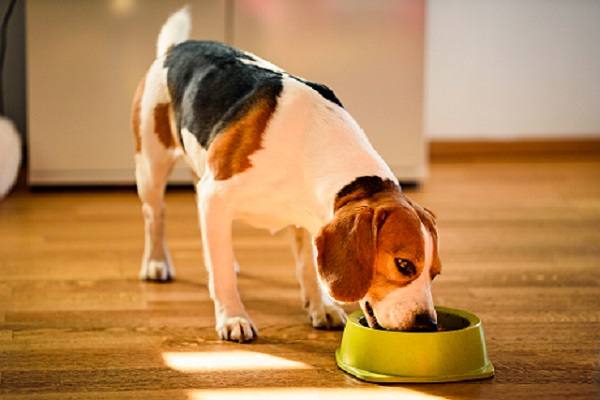Just like people, dogs need nutritious food to stay healthy. There are so many choices for dog food that it can be overwhelming. How do you choose the best food for your dog?
Nutritious Dog Food Starts with Natural Ingredients
As we humans discover more problems related to the food we eat, we can learn some lessons that will help our dogs lead healthier lives. Just like processed food for people, dog foods often contain unhealthy fillers and artificial flavors, colors and preservatives. You might be surprised to learn that many of the big brands of dog food, even those sold by your vet, contain unhealthy ingredients that can cause all kinds of problems for your canine pal.
First, you should understand that dogs need only two things in their diet to stay healthy:
- Animal protein
- Plant protein (optional)
Animal protein comes mainly from – you guessed it – meat. But not all meat is created equal. Like processed meats, such as hot dogs, many dog food producers will use parts of the animal that aren’t all that healthy. They may throw in things that might taste good to your dog (what doesn’t a dog like to eat?), such as brains or other organs, glands and who-knows-what. These ‘extras’ should be listed in the ingredients as ‘by-products.’ What you should look for instead is just meat or meat protein.
In dry dog food, animal or vegetable proteins will often be listed as ‘meal,’ such as chicken meal (aka, poultry meal), fish meal or vegetable meal, since they are dried and ground up. This is fine, but avoid bad types of meal, like those coming up.
Flavors, colors and preservatives should be natural. Artificial ingredients are used because they are cheap (this always seems to come to the top of the list, doesn’t it?).
Avoid Fillers and Grains
Most dog food manufacturers will use one or more grains, such as corn, wheat or soy. These may be listed as ‘meal’ just like meat and vegetables, but grains are best avoided. Why do they use grain? The simple answer is that grain is the cheapest ingredient they can use, other than dirt, perhaps.
Grains will sometimes be disguised as gluten meal. Bone meal is another cheap filler to avoid – your dog doesn’t need it. And as we mentioned above, animal by-products are used as cheap filler and should be avoided.
Dogs are not designed to digest grain, especially modern GMO varieties, which have little in common with their natural ancestors. Regardless of whether a grain is genetically modified or not, find a dog food without grain and avoid a bunch of problems.
Grains are often responsible for allergies in dogs. Skin rashes and chronic itching are commonly attributed to grains, so if your dog has skin problems, check the food for grain. Switching to a grain-free dog food will often solve the problem and avoid unnecessary trips to the vet (and unneeded drugs, like steroids).
Avoid Beef
Of the different meats available, the one that is probably best avoided is beef. While most dogs will do fine with beef, some will have allergic reactions to it. One of our dogs is allergic to beef and grain, so we feed her only grain-free dog food made with fish and vegetable protein. It makes an amazing difference and we have a much happier dog.
Why is beef a problem? I can’t say for sure, but I suspect it may be due to most beef cattle being fed corn instead of grass. Research shows that grass-fed beef is much healthier for people than corn-fed and perhaps the same thing is true for dogs. After all, cattle were not designed to eat corn any more than dogs were designed to eat grain.
Keep the Ingredients List Short
The ingredients on good dog food should be a short list of at least one animal protein along with some vegetable proteins (not grains), though the veggies are optional. Other natural proteins, such as eggs are OK, but the shells should not be included (some dogs do have egg allergies, though, so keep this in mind if you have problems).
Oils and fats are good, as long as they are natural and not hydrogenated (creating trans fats, which are bad). Salmon oil is one of the best, since it is not only good for a healthy coat, but good for the heart, too.
Berries are fine if they are listed. They have ‘antioxidants’ which help dogs (and people, too) repair damage to their bodies at the cellular level. Some vitamins are antioxidants, such as vitamins C and E.
And speaking of vitamins, both vitamin C and E are also used as natural preservatives. These are healthy. Cheap dog food uses artificial preservatives, such as ethoxyquin or propylene glycol. Stay away from these, as they will probably eventually do to your dog what they do to bacteria – kill them.
Watch out for a trick some dog food manufacturers use when listing ingredients. They may list meat first to make you think there is more of it than the other ingredients, but then they may list 2 or 3 cheap fillers, such as corn, wheat and soy meal (or chicken by-products). These cheap ingredients will add up to much more than the good part, giving a false impression of the quality of the dog food. If you look for food without the cheap, unhealthy fillers, you won’t have this problem.
Note that vitamins will often be listed with their chemical names, so don’t mistake these for artificial things that don’t belong. Some dog foods also contain healthy enzymes, probiotics (beneficial bacteria that aid in digestive and immune health) and amino acids. When in doubt, just look up each ingredient online to see what it really is (the manufacturer’s website may be a good source to explain what they are – just don’t fall for claims that grain is good for your dog).




